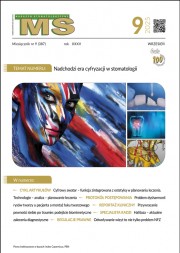Dostęp do tego artykułu jest płatny.
Zapraszamy do zakupu!
Po dokonaniu zakupu artykuł w postaci pliku PDF prześlemy bezpośrednio pod twój adres e-mail.
Streszczenie
Obecnie w stomatologii odtwórczej najczęściej stosuje się światłoutwardzalne materiały kompozytowe, co wynika zarówno z ich korzystnych właściwości, jak i wygody pracy. Jakość tych materiałów zależy jednak w dużej mierze od sposobu i warunków polimeryzacji. W pracy zbadano zmianę natężenia światła w zależności od odległości od naświetlanej powierzchni, imitując trudne warunki kliniczne obecne w przypadku głębokich ubytków. Świadomość występującej wówczas zmiany natężenia światła lampy polimeryzacyjnej pozwala lekarzowi uniknąć niepowodzeń związanych z niedostateczną polimeryzacją materiału kompozytowego.
Abstract
Light cured composite materials are most commonly used in restorative dentistry, both for their good features, as well as for the ease of use. The final quality of these materials relies heavily upon the circumstances of polymerization.
This paper investigates the change of light intensity depending on the elevation above the irradiated surface, which simulates clinical obstacles in case of deep cavities.
The awareness of the degradation of light intensity allows the dentist to avoid failure due to insufficient polymerization of the composite.
Hasła indeksowe: materiał kompozytowy, lampa polimeryzacyjna, natężenie światła
Key words: composite material, polymerisation lamp, light intensity
PIŚMIENNICTWO
1. Rueggeberg F.A. i wsp.: Light curing in dentistry and clinical implications: a literature review. Braz. Oral Res., 2017, 31, suppl. 1, e61. doi: 10.1590/1807-3107BOR-2017.vol31.0061
2. Dudzik K., Iwanicka-Grzegorek E.: Lampy polimeryzacyjne stosowane w stomatologii – rodzaje, zastosowanie i mechanizm polimeryzacji. Borgis – Nowa Stomatol., 2009, 4, 122-127.
3. Hervás-García A. i wsp.: Composite resins. A review of the materials and clinical indications. Med. Oral Patol. Oral Cir. Bucal., 2006, 11, 2, E215-E220.
4. Santini A., Gallegos I.T., Felix C.M.: Photoinitiators in dentistry: a review. Prim. Dent. J., 2013, 2, 4, 30-33.
5. Hofmann N., Hugo B., Klaiber B.: Effect of irradiation type (LED or QTH) on photo-activated composite shrinkage strain kinetics, temperature rise, and hardness. Eur. J. Oral Sci., 2002, 110, 6, 471-479.
6. Millar B.J., Nicholson J.W.: Effect of curing with a plasma light on the properties of polymerizable dental restorative materials. J. Oral Rehabil., 2001, 28, 6, 549-552.
7. Althoff O., Hartung M.: Advances in light curing. Am. J. Dent., 2000, 13, 77D-81D.
8. Dąbrowski M. i wsp.: Badania efektów cieplnych w czasie polimeryzacji stomatologicznych materiałów do wypełnień ubytków. PAK, 2006, 9, 44-47.
9. Krämer N. i wsp.: Light curing of resin-based composites in the LED era. Am. J. Dent., 2008, 21, 3, 135-142.
10. Abate P.F., Zahra V.N., Macchi R.L.: Effect of photopolymerization variables on composite hardness. J. Prosthet. Dent., 2001, 86, 6, 632-635.
11. Rueggeberg F.A.: Precision of hand-held dental radiometers. Quintessence Int., 1993, 24, 6, 391-396.
12. Wichrowska K.: Wpływ warunków polimeryzacyjnych materiałów kompozytowych na stopień ich twardości. Rozprawa doktorska. Uniwersytet Medyczny w Łodzi, 2009.
13. Pries J.A. i wsp.: Effects of curing tip distance on light intensity and composite resin microhardness. Quintessence Int., 1993, 24, 7, 517-521.
14. Aguiar F.H.B. i wsp.: Effect of light curing tip distance and resin shade on microhardness of a hybrid resin composite. Braz. Oral Res., 2005, 19, 4, 302-306.
15. Wichrowska K.: Ocena natężenia światła lamp polimeryzacyjnych w zależności od kąta ustawienia końcówki światłowodu. Mag. Stomatol. 2014, XXIV, 1, 99-103 (ON-LINE).
16. Herda E i wsp. Light-curing distance and resin thickness effects on the short fiber–reinforced resin composites’ depth of cure. Int. J. App. Pharm., 2017, 9, Spec. Iss. 2, 110-113.
17. Vandewalle K.S. i wsp.: Effect of light dispersion of LED curing lights on resin composite polymerization. J. Esthet. Restor. Dent., 2005, 17, 4, 244-255.
18. Albers H.F. (red.): Direct composite restoratives. ADEPT Report, 1991, 2, 53-64.
19. Mutluay M.M., Rueggeberg F.A., Price R.B.: Effect of using proper light-curing techniques on energy delivered to a Class 1 restoration. Quintessence Int., 2014, 45, 7, 549-556. doi: 10.3290/j.qi.a31959
20. Samaha S. i wsp.: Effect of instruction, light curing unit, and location in the mouth on the energy delivered to simulated restorations. Am. J. Dent., 2017, 30, 6, 343-349.
21. Maktabi H. i wsp.: Factors influencing success of radiant exposure in light-curing posterior dental composite in the clinical setting. Am. J. Dent., 2018, 31, 6, 320-328.
22. Aguiar F.H. i wsp.: Effect of light curing modes and light curing time on the microhardness of a hybrid composite resin. J. Contemp. Dent. Pract., 2007, 8, 6, 1-8.
23. Atmadja G., Bryant R.W.: Some factors influencing the depth of cure of visible light-activated composite resin. Aust. Dent. J., 1990, 35, 3, 213-218.














